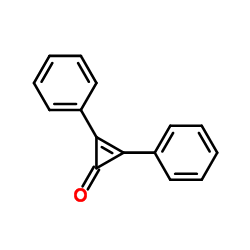DPC

DPC structure
|
Common Name | DPC | ||
|---|---|---|---|---|
| CAS Number | 886-38-4 | Molecular Weight | 206.239 | |
| Density | 1.2±0.1 g/cm3 | Boiling Point | 407.2±45.0 °C at 760 mmHg | |
| Molecular Formula | C15H10O | Melting Point | 118-122 °C(lit.) | |
| MSDS | Chinese USA | Flash Point | 182.7±23.7 °C | |
| Symbol |

GHS07 |
Signal Word | Warning | |
|
Differential signaling by regulatory subunits of phosphoinositide-3-kinase influences cell survival in INS-1E insulinoma cells.
Exp. Clin. Endocrinol. Diabetes 123(2) , 118-25, (2015) Class 1A phosphoinositide 3-kinase (PI3K) is essential for beta-cell growth and survival. Although PI3K has been studied extensively in diabetes the effect of alternatively spliced isoforms of the catalytic subunit p85α on beta cell proliferation and survival... |
|
|
Spider wrapping silk fibre architecture arising from its modular soluble protein precursor.
Sci. Rep. 5 , 11502, (2015) Spiders store spidroins in their silk glands as high concentration aqueous solutions, spinning these dopes into fibres with outstanding mechanical properties. Aciniform (or wrapping) silk is the toughest spider silk and is devoid of the short amino acid seque... |
|
|
Disease mutations in desmoplakin inhibit Cx43 membrane targeting mediated by desmoplakin-EB1 interactions.
J. Cell Biol. 206(6) , 779-97, (2014) Mechanisms by which microtubule plus ends interact with regions of cell-cell contact during tissue development and morphogenesis are not fully understood. We characterize a previously unreported interaction between the microtubule binding protein end-binding ... |
|
|
Interaction of a peptide derived from C-terminus of human TRPA1 channel with model membranes mimicking the inner leaflet of the plasma membrane.
Biochim. Biophys. Acta 1848(5) , 1147-56, (2015) The transient receptor potential ankyrin 1 channel (TRPA1) belongs to the TRP cation channel superfamily that responds to a panoply of stimuli such as changes in temperature, calcium levels, reactive oxygen and nitrogen species and lipid mediators among other... |
|
|
Squalene-containing nanostructured lipid carriers promote percutaneous absorption and hair follicle targeting of diphencyprone for treating alopecia areata.
Pharm. Res. 30(2) , 435-46, (2013) Diphencyprone (DPCP) is a therapeutic agent for treating alopecia areata. To improve skin absorption and follicular targeting nanostructured lipid carriers (NLCs) were developed.Nanoparticles were characterized by size, zeta potential, molecular environment, ... |
|
|
Bone resorption correlates with the frequency of CD5⁺ B cells in the blood of patients with rheumatoid arthritis.
Rheumatology (Oxford.) 54(3) , 545-53, (2015) The prevention of bone resorption and subsequent joint destruction is one of the main challenges in the treatment of patients suffering from RA. Various mechanisms have previously been described that contribute to bone resorption in tightly defined cohorts. H... |
|
|
Solution structure of the transmembrane domain of the mouse erythropoietin receptor in detergent micelles.
Sci. Rep. 5 , 13586, (2015) Erythropoiesis is regulated by the erythropoietin receptor (EpoR) binding to its ligand. The transmembrane domain (TMD) and the juxtamembrane (JM) regions of the EpoR are important for signal transduction across the cell membrane. We report a solution NMR stu... |
|
|
Structural study of caveolin-1 intramembrane domain by circular dichroism and nuclear magnetic resonance.
Biopolymers 104 , 11-20, (2015) Caveolin-1 is a main structural component of caveolae and essential for the invagination of caveolae by forming a hairpin-shaped structure in the membrane-inserting domain (residues, 102-122). In this article, we determined the tertiary structures of the pept... |
|
|
Functional characterization of the human facilitative glucose transporter 12 (GLUT12) by electrophysiological methods.
Am. J. Physiol. Cell Physiol. 308 , C1008-22, (2015) GLUT12 is a member of the facilitative family of glucose transporters. The goal of this study was to characterize the functional properties of GLUT12, expressed in Xenopus laevis oocytes, using radiotracer and electrophysiological methods. Our results showed ... |
|
|
The effects of hypokalaemia on the hormone exocytosis in adenohypophysis and prolactinoma cell culture model systems.
Exp. Clin. Endocrinol. Diabetes 122(10) , 575-81, (2014) The extracellular ion milieu determines the exocytosis mechanism that is coupled to spontaneous electrical activity. The K(+) ion plays crucial role in this mechanism: as the potassium current is associated with membrane hyperpolarization and hormone release ... |